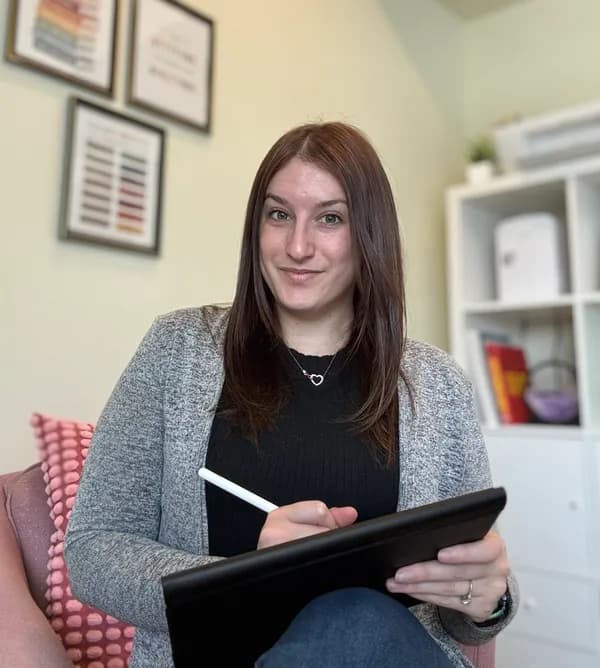Therapy for assertiveness & boundaries

You say yes when you mean no. You overextend yourself until you're exhausted and resentful. Maybe you avoid conflict at all costs, let others walk over you, or feel guilty every time you prioritize your own needs. Perhaps you swing between being a doormat and exploding in anger, never finding that middle ground. Learning to set boundaries and speak up for yourself isn't selfish—it's essential for healthy relationships and your own wellbeing. Let's explore how therapy can help you find your voice and protect your peace.
Understanding assertiveness and boundaries
What assertiveness really means
Assertiveness is not about being harsh or selfish. It is the confident and respectful way of expressing what you need, how you feel, and where your limits are. It lets you say no without guilt, share your views without apologizing, and stand up for yourself while staying kind.
The importance of healthy boundaries
Boundaries are not walls. They are intentional gates you control, shaping what you allow into your life and what you keep out. Clear boundaries protect your energy, strengthen your relationships, and are strongly linked to lower stress and burnout.
Assertiveness & boundary-setting challenges
Sources:Canada Safety Training (burnout symptoms survey) andStatistics Canada (relationship satisfaction)
The cost of weak boundaries and passive communication
Chronic resentment and burnout
Saying yes while ignoring your own needs builds resentment that grows quietly in the background. You may feel frustrated with people you care about even though you never said no. Over time the exhaustion becomes overwhelming. Studies show that weak boundaries increase burnout, compassion fatigue, and emotional exhaustion. You keep pushing until you have nothing left to give.
Relationships built on false pretences
When you are not open about what you need or where your limits are, others do not get to know the real you. They only see the agreeable version you present. This weakens intimacy because real closeness requires honesty. You may attract people who take more than they give, not out of bad intentions, but because you have shown that you always give without asking for anything in return. Meanwhile you feel unseen and unappreciated even when you are doing everything right.
Loss of identity and self worth
When you focus on others first, you drift away from your own needs and values. You may no longer know what you enjoy or what truly matters to you. Your sense of worth becomes tied to how helpful you are rather than who you are. Over time you may realise you no longer know what you want because you stopped allowing yourself to want anything at all.
Anxiety and people pleasing cycle
Weak boundaries create constant worry. You fear disappointing others or being judged, which leads to more people pleasing. This leaves you stretched thin and resentful which increases your anxiety even more. The pattern can lead to passive avoidance or sudden emotional outbursts that leave you feeling guilty and misunderstood.
How therapy builds assertiveness and healthy boundaries
Learning skills and addressing root causes
Assertiveness therapy supports you in two ways. You learn clear, practical communication skills so you can say no, make requests, and express your feelings with confidence. You also look at why boundaries have been difficult for you. This may come from early family experiences, a belief that your needs were less important, or cultural expectations that encouraged you to be agreeable at all times. Understanding these roots makes it easier to break old patterns and create healthier ones.
What happens in assertiveness therapy
Therapy focuses on the places where boundaries feel hardest. You and your therapist explore your communication habits, the fears that make saying no difficult, and what happens in your body when you try to speak up. You also practise new skills through supportive role play and learn phrases that feel natural to you. As you try these skills in real life, your therapist helps you manage the guilt and anxiety that show up so you can build healthier, more confident patterns.
Therapeutic approaches for assertiveness
Assertiveness training
Assertiveness training is a structured way to build communication skills. You learn the difference between passive, aggressive, and assertive responses and practise techniques such as using "I" statements, calmly repeating your boundary, and acknowledging criticism without taking it on. Role play helps you feel prepared so you can use these tools in real situations with more confidence.
Cognitive Behavioural Therapy (CBT)
CBT focuses on the thoughts and beliefs that make setting boundaries difficult. You identify patterns such as catastrophizing, assuming others see you as selfish, or believing you must always help. Your therapist guides you in challenging these thoughts, replacing them with more balanced perspectives, and learning to tolerate the discomfort that comes with saying no.
Schema therapy
Schema therapy helps you understand long standing patterns that formed in childhood. You might recognise beliefs such as thinking your needs do not matter or relying on others for approval. This approach helps you uncover where these patterns came from, challenge them, and replace them with healthier beliefs about your worth and your right to set limits.
Internal Family Systems (IFS)
IFS views your inner world as having different parts such as a pleaser part that avoids conflict or a frustrated part that reacts when you feel unheard. Therapy helps you understand what each part is trying to protect you from so you can respond with more balance and less internal conflict when you set boundaries.
Dialectical Behavior Therapy (DBT) skills
DBT provides practical tools for assertiveness. The DEAR MAN steps help you describe a situation, express feelings, assert your needs, explain the benefit, stay mindful, appear confident, and negotiate. GIVE skills guide you to be gentle, stay interested, validate others, and use an easy manner so you can set boundaries while maintaining connections.
Feminist therapy and cultural considerations
Feminist and culturally informed therapy explores how gender roles and cultural expectations shape assertiveness. Many people are taught to be accommodating or fear backlash for speaking up. This approach helps you understand these pressures and supports you in setting boundaries in ways that respect your values and cultural context while still honouring your needs.
The journey to becoming more assertive
Assessment and awareness building
Early sessions focus on understanding your patterns such as where you learned to hide your needs, what fears appear when you consider saying no, and who in your life crosses your limits most often. You start noticing habits you once overlooked like apologizing automatically or justifying every preference. This stage builds awareness so you can observe yourself with curiosity rather than criticism.
Skill-building and practice
Middle sessions focus on practising clear, confident communication through role play such as saying no, asking for help, or setting limits with family. Assertive language often feels awkward at first which is normal. You then practise in real life with simple situations and gradually move toward more challenging ones like advocating for yourself at work or setting fair expectations at home.
Addressing emotional barriers
As you begin setting boundaries, emotions such as guilt, anxiety, and fear often surface. Your therapist helps you understand that these feelings are not evidence you did something wrong. You learn to tolerate discomfort and recognise that someone’s disappointment does not require you to abandon your boundary or rescue them from their reaction.
Dealing with pushback and staying firm
When you change long standing patterns, some people may resist or guilt trip you. Therapy helps you prepare for these reactions, stay grounded, and recognise when a relationship is not healthy. You practise calm responses to common challenges such as “You always help me” and hold firm with clear statements like “I hear your disappointment and my answer is still no.”
Timeline and sustainable change
Many people notice improvements within six to eight weeks as saying no becomes easier and unnecessary apologies decrease. A full course often lasts ten to twenty sessions depending on your history and goals. Success means expressing needs without excessive guilt, maintaining boundaries even when others feel disappointed, and believing you deserve space and support in your relationships.
Find a therapist who specializes in assertiveness & boundaries
Choosing the right therapist matters. Each province in Canada has its own regulations, which is why working with a recognized professional can make a real difference in your care. Stellocare takes the uncertainty out of the process by listing only verified therapists you can trust.
The right therapist for you
No therapists found with these specialties in Ontario.
Try selecting a different province.Resources and strategies for building assertiveness
Canadian resources and support
Community life-skills and communication programs
North York Community House (Toronto)offers free community programs for adults and newcomers that include communication skills, self-advocacy, conflict skills and practical boundary-setting in everyday life.
Newcomer communication & self-advocacy support
MOSAIC (British Columbia)provides free programs for adults and youth including settlement workshops, workplace communication, self-advocacy skills and interpersonal communication for real-life situations.
Youth communication & leadership development
YMCA Canadaruns youth and young adult leadership programs across Canada that include communication skills, conflict resolution, teamwork, boundary-setting and confidence-building.
Family & relationship communication support
Family Services of Greater Vancouveroffers community groups and skill-building programs that focus on healthy communication, emotional boundaries and relationship skills for individuals and families.
Life-skills and self-management programs
John Howard Society (Canada-wide)delivers community-based life-skills programs across several provinces, including interpersonal skills, conflict management and communication for adults seeking personal growth and stronger boundaries.
General learning & communication for adults
TDSB Community Services (Toronto)provides free adult programs including communication skills, conflict resolution and self-advocacy training through newcomer services and community learning centres.
Practical assertiveness techniques
The power of "no" without explanation
Practice saying no without justifying: "No, I can't do that." Not "No, because I have this thing and my car broke down and..." When you over-explain, you invite negotiation. A simple "That doesn't work for me" is complete. You don't owe everyone detailed explanations for your decisions. If they push, use the broken record technique: calmly repeat your boundary without elaboration.
Using "I" statements effectively
Structure requests and concerns using "I" statements: "I feel frustrated when meetings run late because I need to pick up my kids. I need us to stick to scheduled end times." This is more effective than "You always make meetings run late." I-statements express your experience without attacking, making others less defensive and more likely to respond constructively.
The boundary sandwich
When setting boundaries, try this structure: acknowledgment + boundary + alternative or reinforcement. "I appreciate you thinking of me for this project (acknowledgment), and I don't have capacity to take it on right now (boundary). I'd be happy to help next month if it's still relevant (alternative)." This maintains relationship while setting limits.
Buying time instead of automatic yes
When asked for something, practice saying "Let me check my calendar and get back to you" or "I need to think about that." This gives you time to consider whether you actually want to say yes, check with your partner if needed, and respond thoughtfully rather than automatically agreeing out of reflex. Most requests can wait for a response.
Body language and tone
Assertiveness isn't just words. Stand or sit up straight, make appropriate eye contact, keep your voice calm and steady, avoid apologetic body language (hunching, excessive smiling, nervous laughing). Your nonverbal communication reinforces your message. Practice in a mirror or record yourself to build awareness of how you physically present.
Dealing with guilt and pushback
When someone pushes back against your boundary, remember: their disappointment is not your emergency. Repeat your boundary calmly without arguing or defending. If they guilt-trip you ("I thought we were friends," "You're being selfish"), respond simply: "I understand you're disappointed. My answer is still no." You're allowed to prioritize yourself even when it inconveniences others.
Common questions about assertiveness therapy
Isn't being assertive just being selfish?
No. Selfishness means ignoring others’ needs. Assertiveness means valuing your needs equally to others’. It allows you to be clear, respectful, and honest which reduces resentment and strengthens relationships. People trust direct communicators far more than people-pleasers.
What if people get angry when I set boundaries?
Some people may react poorly at first because they were used to you saying yes. Their reaction reflects their expectations, not wrongdoing on your part. People who care about you will adjust. Those who refuse to respect your limits may not be healthy relationships to keep.
Can I be assertive if my culture values collectivism over individualism?
Yes. Assertiveness can be expressed in culturally respectful ways. It is not about rejecting your culture but balancing your wellbeing with collective values. A culturally informed therapist can help you find approaches that honour both.
What's the difference between assertiveness and aggression?
Assertiveness is calm, respectful, and focused on your needs. Aggression attacks or disregards others’ rights. Some people mix them up because they have only seen extreme behaviour. Healthy assertiveness communicates clearly without harming anyone.
How do I become assertive without feeling fake?
New behaviours feel awkward at first which is normal. With practice and language that fits your personality, assertiveness becomes natural. Over time expressing your needs feels more authentic than suppressing them.
What if I go too far and become aggressive?
It is common to overcorrect when you are used to people-pleasing. Therapy helps you find the healthy middle ground. If you speak too harshly, you can repair it and try again with more balance which is part of learning the skill.
Can therapy help with assertiveness at work specifically?
Yes. Workplace assertiveness involves unique pressures such as power dynamics and career concerns. Therapy can support you with asking for raises, declining unreasonable tasks, handling difficult colleagues, and setting healthier work-life boundaries.
Related concerns
References
- Lancer, D. (2014). Conquering Shame and Codependency: 8 Steps to Freeing the True You. Hazelden Publishing.
- Maslach, C., & Leiter, M. P. (2016). Understanding the burnout experience: recent research and its implications for psychiatry. World Psychiatry, 15(2), 103-111. Retrieved from https://pmc.ncbi.nlm.nih.gov/articles/PMC4911781/
- Speed, B. C., Goldstein, B. L., & Goldfried, M. R. (2018). Assertiveness training: A forgotten evidence‐based treatment. Clinical Psychology: Science and Practice, 25(1), e12216. Retrieved from https://psycnet.apa.org/record/2017-48640-001
- Canadian Women's Foundation. (2024). Resources. Retrieved from https://canadianwomen.org/
- Paterson, R. J. (2000). The Assertiveness Workbook: How to Express Your Ideas and Stand Up for Yourself at Work and in Relationships. New Harbinger Publications.
About Stellocare
Stellocare is a Canadian platform where you can find the best fit therapist for you. Search the right thperaists now by asking our AI, browsing our list, or finding our social workers for personal referral.

Veronica Kozak
Registered Psychotherapist (Qualifying) (ON)

Ed Chen
Registered Clinical Counsellor (BC)

Melodi Laframboise
Registered Psychotherapist (ON)

Christine Chambers
Registered Psychotherapist (ON)

Kate MacDonald
Registered Psychologist (AB)

Amelie Rossignol
Counselling Therapist (AB)

Stacy Kirkbride
Registered Psychotherapist (ON)

Kimia Taghavi
Registered Psychotherapist (Qualifying) (ON)

Cindy Rose
Registered Psychotherapist (ON)

Shani Ellis-Alman
Registered Social Worker (ON)

Andrea Laurie
Canadian Certified Counsellor

Natasha Elliott
Registered Psychotherapist (ON)

Manishapreet Grewal
Registered Psychotherapist (Qualifying) (ON)

Yamila Luner
Canadian Certified Counsellor

Elena Temelkova
Registered Psychotherapist (Qualifying) (ON)

Joanne Prysunka
Canadian Certified Counsellor

Renée LaJoie
Counselling Therapist (AB)

Vrushalee Nachar
Registered Psychotherapist (ON)

Ilona Farry
Registered Psychotherapist (Qualifying) (ON)

Monika Goetz
Registered Social Worker (ON)

Veronica Kozak
Registered Psychotherapist (Qualifying) (ON)

Ed Chen
Registered Clinical Counsellor (BC)

Melodi Laframboise
Registered Psychotherapist (ON)

Christine Chambers
Registered Psychotherapist (ON)

Kate MacDonald
Registered Psychologist (AB)

Amelie Rossignol
Counselling Therapist (AB)

Stacy Kirkbride
Registered Psychotherapist (ON)

Kimia Taghavi
Registered Psychotherapist (Qualifying) (ON)

Cindy Rose
Registered Psychotherapist (ON)

Shani Ellis-Alman
Registered Social Worker (ON)

Andrea Laurie
Canadian Certified Counsellor

Natasha Elliott
Registered Psychotherapist (ON)

Manishapreet Grewal
Registered Psychotherapist (Qualifying) (ON)

Yamila Luner
Canadian Certified Counsellor

Elena Temelkova
Registered Psychotherapist (Qualifying) (ON)

Joanne Prysunka
Canadian Certified Counsellor

Renée LaJoie
Counselling Therapist (AB)

Vrushalee Nachar
Registered Psychotherapist (ON)

Ilona Farry
Registered Psychotherapist (Qualifying) (ON)

Monika Goetz
Registered Social Worker (ON)

